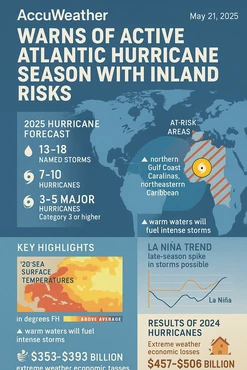AccuWeather forecasts 13-18 named storms, many reaching far inland
May 21, 2025
- AccuWeather forecasts 1318 named storms, up to 10 hurricanes, and as many as 6 direct U.S. impacts for 2025.
-
Experts warn of storms reaching far inland, driven by record-warm ocean waters and a possible late-season La Nia.
-
The season could mirror 2024s devastation, with risks especially high for the Gulf Coast, Carolinas, and northeastern Caribbean.

After a catastrophic 2024 Atlantic hurricane season, AccuWeathermeteorologists are sounding the alarm about a potentially destructive repeat in 2025. Warmer-than-average ocean temperatures, shifting jet streams, and a possible return of La Nia by fall have experts urging inland and coastal communities alike to brace for high-impact storms.
We saw last year how far inland storms can reach, said AccuWeather Lead Hurricane Expert Alex DaSilva. Hurricane Beryl produced more than 60 tornadoes on a path from Texas to New York, and Hurricane Helene triggered deadly flooding in the southern Appalachians. Similar risks are looming again this year.
The 2025 forecast calls for:
-
1318 named storms
-
710 hurricanes
-
35 major hurricanes (Category 3 or stronger)
-
36 direct impacts to the U.S.
Theres also a 20% chance of more than 18 named storms, mirroring the hyperactive 2024 season.
Key Drivers of the 2025 Hurricane Season:
-
Above-Average Atlantic Ocean Heat: Warm waters across the Atlantic, Gulf, and Caribbean Sea are expected to persistpriming storms for rapid intensification.
-
Risk of Homegrown Storms: Early and late-season development along the Gulf Coast may be fueled by stalled cold fronts.
-
Deep Ocean Heat Content: The deeper the warmth goes, the stronger a storm can become.
-
La Nias Possible Return: A late-season La Nia could ramp up tropical activity into November.
-
African Weather Patterns: More tropical waves from Africa and fewer dry Saharan dust clouds may increase storm numbers.
At-Risk Regions:
-
Northern & Eastern Gulf Coast
-
The Carolinas
-
Northeastern Caribbean (including U.S. Virgin Islands and Puerto Rico)
-
Atlantic Canada
People in these areas need to be ready now, DaSilva emphasized.
Economic Toll from Extreme Weather
So far in 2025, the U.S. has already faced:
-
$353B$393B in damages from tornadoes, floods, wildfires, and winter storms
-
$457B$506B in damage from the 2024 hurricane season alone
Another round of major landfalls could strain FEMA, insurers, and local governments to the breaking point.
Analog Years Show High-Risk Pattern
Meteorologists analyzed 12 analog yearspast hurricane seasons with similar ocean and atmospheric patterns. Matches include:
-
2017: Hurricane Harvey (TX)
-
2023: Hurricane Idalia (FL)
-
2024: Beryl, Helene, and multiple billion-dollar disasters
This model boosts forecast accuracy by using historical data to anticipate the most likely storm paths and outcomes.
Unpredictable Influences
-
Bermuda-Azores High: A weaker high favors re-curving storms that stay at sea; a stronger one pushes systems into the Caribbean and Gulf.
-
Atlantic Nio/ Nia: Dry air and cooler waters can temporarily pause storm activity, but any warming in the eastern Atlantic could reverse that trend fast.
Timeline to Watch
-
June: Early-season storms likely due to stalled jet stream dips over warm waters.
-
JulyAugust: Potential lull from dry air or Atlantic Nia.
-
SeptemberNovember: A late-season spike expected if La Nia formsmirroring last years activity.
Peak Date: Sept. 10
#Inland #areas #greater #risk #hurricane #season #intensifies